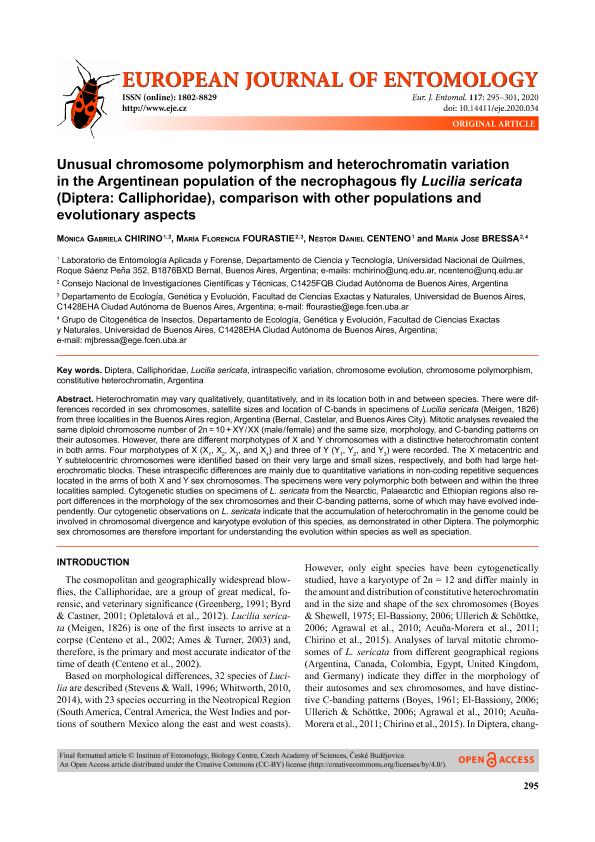Artículo
Unusual chromosome polymorphism and heterochromatin variation in the Argentinean population of the necrophagous fly Lucilia sericata (Diptera: Calliphoridae), comparison with other populations and evolutionary aspects
Fecha de publicación:
07/2020
Editorial:
Czech Academy of Sciences
Revista:
European Journal of Entomology (Ceske Budejovice)
ISSN:
1210-5759
Idioma:
Inglés
Tipo de recurso:
Artículo publicado
Clasificación temática:
Resumen
Heterochromatin may vary qualitatively, quantitatively, and in its location both in and between species. There were differences recorded in sex chromosomes, satellite sizes and location of C-bands in specimens of Lucilia sericata (Meigen, 1826) from three localities in the Buenos Aires region, Argentina (Bernal, Castelar, and Buenos Aires City). Mitotic analyses revealed the same diploid chromosome number of 2n = 10 + XY / XX (male / female) and the same size, morphology, and C-banding patterns on their autosomes. However, there are different morphotypes of X and Y chromosomes with a distinctive heterochromatin content in both arms. Four morphotypes of X (X1, X2, X3, and X4) and three of Y (Y1, Y2, and Y3) were recorded. The X metacentric and Y subtelocentric chromosomes were identified based on their very large and small sizes, respectively, and both had large heterochromatic blocks. These intraspecific differences are mainly due to quantitative variations in non-coding repetitive sequences located in the arms of both X and Y sex chromosomes. The specimens were very polymorphic both between and within the three localities sampled. Cytogenetic studies on specimens of L. sericata from the Nearctic, Palaearctic and Ethiopian regions also report differences in the morphology of the sex chromosomes and their C-banding patterns, some of which may have evolved independently. Our cytogenetic observations on L. sericata indicate that the accumulation of heterochromatin in the genome could be involved in chromosomal divergence and karyotype evolution of this species, as demonstrated in other Diptera. The polymorphic sex chromosomes are therefore important for understanding the evolution within species as well as speciation.
Archivos asociados
Licencia
Identificadores
Colecciones
Articulos(IEGEBA)
Articulos de INSTITUTO DE ECOLOGIA, GENETICA Y EVOLUCION DE BS. AS
Articulos de INSTITUTO DE ECOLOGIA, GENETICA Y EVOLUCION DE BS. AS
Citación
Chirino, Monica Gabriela; Fourastié, María Florencia; Centeno, Néstor Daniel; Bressa, Maria Jose; Unusual chromosome polymorphism and heterochromatin variation in the Argentinean population of the necrophagous fly Lucilia sericata (Diptera: Calliphoridae), comparison with other populations and evolutionary aspects; Czech Academy of Sciences; European Journal of Entomology (Ceske Budejovice); 117; 7-2020; 295-301
Compartir
Altmétricas




